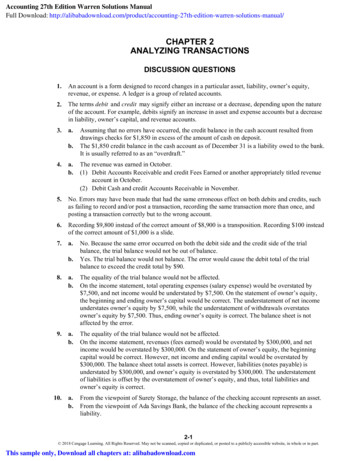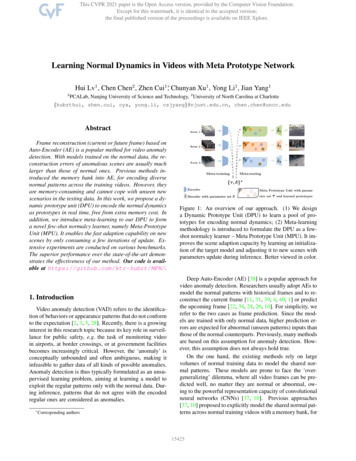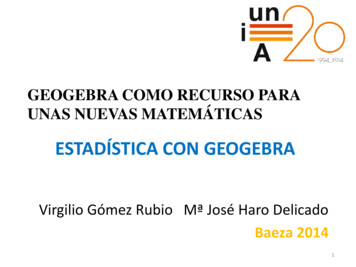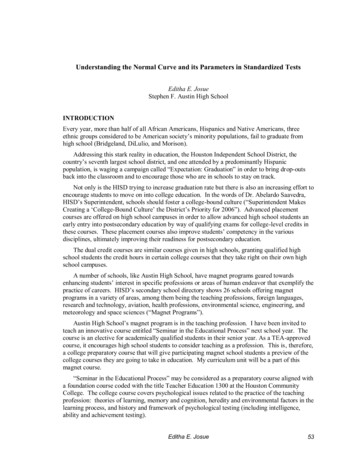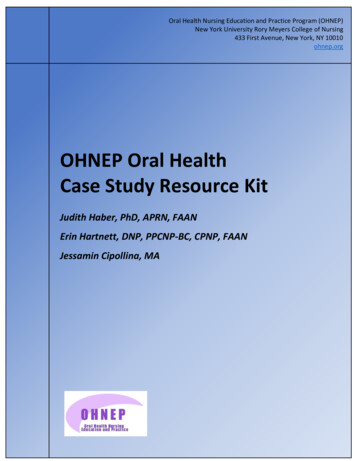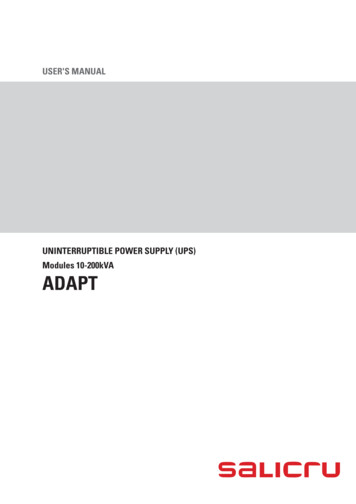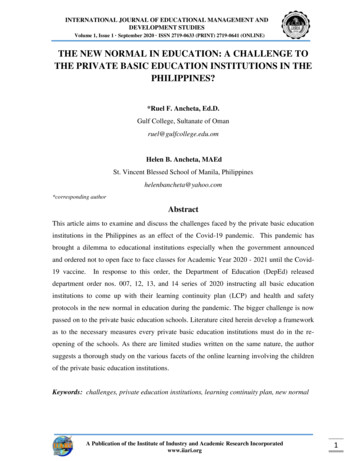
Transcription
INTERNATIONAL JOURNAL OF EDUCATIONAL MANAGEMENT ANDDEVELOPMENT STUDIESVolume 1, Issue 1 · September 2020 · ISSN 2719-0633 (PRINT) 2719-0641 (ONLINE)THE NEW NORMAL IN EDUCATION: A CHALLENGE TOTHE PRIVATE BASIC EDUCATION INSTITUTIONS IN THEPHILIPPINES?*Ruel F. Ancheta, Ed.D.Gulf College, Sultanate of Omanruel@gulfcollege.edu.omHelen B. Ancheta, MAEdSt. Vincent Blessed School of Manila, Philippineshelenbancheta@yahoo.com*corresponding authorAbstractThis article aims to examine and discuss the challenges faced by the private basic educationinstitutions in the Philippines as an effect of the Covid-19 pandemic. This pandemic hasbrought a dilemma to educational institutions especially when the government announcedand ordered not to open face to face classes for Academic Year 2020 - 2021 until the Covid19 vaccine.In response to this order, the Department of Education (DepEd) releaseddepartment order nos. 007, 12, 13, and 14 series of 2020 instructing all basic educationinstitutions to come up with their learning continuity plan (LCP) and health and safetyprotocols in the new normal in education during the pandemic. The bigger challenge is nowpassed on to the private basic education schools. Literature cited herein develop a frameworkas to the necessary measures every private basic education institutions must do in the reopening of the schools. As there are limited studies written on the same nature, the authorsuggests a thorough study on the various facets of the online learning involving the childrenof the private basic education institutions.Keywords: challenges, private education institutions, learning continuity plan, new normalA Publication of the Institute of Industry and Academic Research Incorporatedwww.iiari.org1
INTERNATIONAL JOURNAL OF EDUCATIONAL MANAGEMENT ANDDEVELOPMENT STUDIESVolume 1, Issue 1 · September 2020 · ISSN 2719-0633 (PRINT) 2719-0641 (ONLINE)1. IntroductionThe operation of the private basic education institutions in the country and around theworld was severely affected by the COVID-19 pandemic which began in December 2019. Itbecame a worldwide health crisis where everyone were literally affected regardless of age,gender and social status. The world stopped and economy collapsed as all businessesshutdown operations. For instance, most countries closed the schools, colleges anduniversities to contain the spread of the virus. The crisis became a dilemma not only to thehealth sectors but also to the education sectors. When the Philippine government orderedclosures of all educational institutions, the disruptions were sudden since classes were stillrunning. At the height of the pandemic, educational institutions came out with remotelearning as an alternative solution. The immediate action and strategy aims to mitigate theclosure while continuously delivering quality education.The sudden shift to online learning created a hot debate in the Philippines citing thepoor living conditions of the learners. Magsambol (2020) cites an obvious gap between thosewho can and cannot afford the resources to avail the new education platform. The generalcondition of children in the public school system sends a message of inequality with theDepEd’s mantra ‘no child left behind.’ However, learning cannot be cancelled as much as todrive the economy. This led to a tighter measures for education institutions in sustaining itsoperations despite the impending risk.One of the basic problems seen by Kasrekar (2020) is the conduct of classes despiteof the closure order. As the face to face classes pose higher risk of spread, the most viablesolution is through online teaching and learning. This platform challenges both the teachersand the students as it occurs something new to them. This calls for an ‘adopt quickly’response to the new normal in teaching and learning amidst the pandemic (TanhuecoTumapon, 2020). The shift to online learning was too sudden at a very short notice butacademic institutions have to strategize and accelerate new forms of teaching pedagogy. Thequestion of how ready the schools are in terms of technical infrastructure is still leftunanswered. Reopening of the schools at this stage is really expensive (Felter & Maizland,2020).A Publication of the Institute of Industry and Academic Research Incorporatedwww.iiari.org2
INTERNATIONAL JOURNAL OF EDUCATIONAL MANAGEMENT ANDDEVELOPMENT STUDIESVolume 1, Issue 1 · September 2020 · ISSN 2719-0633 (PRINT) 2719-0641 (ONLINE)The current educational situation in the Philippines seem depressing. From the latestdata release by the Department of Education as of July 2020, the initial enrollment is just alittle over half of the 2019’s 27.7 million students. The decline in the number of enrollees ismainly attributed to financial factors and access to internet. While the public school systemstruggles for the resources in the remote learning, the private educational institutions facebigger threats of closure. In the DepEd data, only 866,935 registered in the private schools, adecline from 4 million in 2019. There are over 200,000 students who transferred from privateto public schools due to economic downturn. Magsambol (2020) cites that the CoordinatingCouncil of Private Educational Associations posed threat of closure of over 400 privateschools due to lack of enrollees.Private basic education institutions in the Philippines are not funded by thegovernment. They operate in accordance with the laws and regulations set by DepEd andfollow the same curriculum as the public schools. The public school is basically free, butparents with financial capacity opt to send their children to private schools due to smallerclass size and better facilities and resources. The role of the private basic educationinstitutions in the Philippines play a vital role in educating the minds of young Filipinos interms of quality services (Acidre, 2019). The House Bill 4813 created the Bureau of PrivateSchools (BPS) that regulates the conduct of educational programs of all private basiceducation institutions in accordance with the DepEd standards. The bureau undertakesstudies and prepares prototype curricular designs and guidelines to improve the curricularofferings of the private schools. All the programs and activities of the private educationinstitutions are still under the supervision of DepEd (Carcamo 2014).This article examines the challenges faced by the private basic education institutionsin the Philippines brought by the effect of the Covid-19 pandemic. It particularly assesses thedifferent factors considered prior to the reopening and how it changes the operations of theprivate schools. It presents the requirements set by the government and the challenges facedby the schools in compliance to the orders.2. MethodologyThis study is a literature review. Literature-based methodology is an effective tool toprovide description, summary and critical evaluation of the existing literatures as the sourcesA Publication of the Institute of Industry and Academic Research Incorporatedwww.iiari.org3
INTERNATIONAL JOURNAL OF EDUCATIONAL MANAGEMENT ANDDEVELOPMENT STUDIESVolume 1, Issue 1 · September 2020 · ISSN 2719-0633 (PRINT) 2719-0641 (ONLINE)of information. It can also broadly described as a systematic way of collecting andsynthesizing previous research (Snyder, 2019).The sources of information were the various DepEd orders which include DepEd OrderNos. 007, 013, and 014 s. 2020. In addition, the DOH AO No. 0015 s. 2020 was used. Theauthor reviewed the contents of the DepEd Orders and DOH administrative orders to developa framework of preparations checklist for the opening of classes in the new normal forSchool Year 2020-2021. After identifying all the requirements, details were presented anddiscussed. The author based the arguments from the current situations as well as citedliterature and studies. Due to the limited studies in the Philippines, the actual experience ofthe authors in running their own private school were considered for the analysis anddiscussion.3. Results and DiscussionMost countries all over the world are focused on how to start the new school yearwithin the ‘new normal’ of teaching and learning without depriving the students of their rightto quality education. The public and private academic institutions in the Philippines areinstructed by DepEd to come up with a learning continuity plan (LCP) for school year 2020 2021. LCP is a package of education intervention in response to the challenges in basiceducation brought by Covid-19 pandemic. This strategic plan is designed to carry out theconduct of classes amidst pandemic. It is a commitment of the government in protecting thehealth and safety of learners, teachers, and school personnel under the health protocol of theDepartment of Health (DOH) and the World Health Organization (DepEd Order Nos. 12and 13, 2020). Apart from the LCP, all private basic education institutions are required tocome up with the school plan for compliance with the minimum health standards as per DOHguidelines on the risk-based public health standards for COVID-19 mitigation (DOH AONo.0015, 2020). All these requirements need to be submitted to DepEd office before theopening of the school year 2020 - 2021 (DepEd Order No. 14, 2020).3.1 The Learning Continuity PlanPer DepEd Order Nos. 12 and 13 s. 2020, the LCP contains two major parts: therationale and the operationalization home-based learning through modular, online or aA Publication of the Institute of Industry and Academic Research Incorporatedwww.iiari.org4
INTERNATIONAL JOURNAL OF EDUCATIONAL MANAGEMENT ANDDEVELOPMENT STUDIESVolume 1, Issue 1 · September 2020 · ISSN 2719-0633 (PRINT) 2719-0641 (ONLINE)combination of modular and online (blended approach). The rationale is an easy part of theLCP as it only indicates the nature of the school which include government recognition orpermit number, accreditation, and its classification whether small, medium or big school. Italso includes the location of the school, summary of the number of students for the past twoschool years, number of administrators, teaching and non-teaching staff, and number ofclassrooms and other facilities. The number of currently enrolled students are included in therationale. In reality, this part shows a drastic decrease on the number of current enrolment inmost of the private basic education institutions as compared to the past two years data. Thisis because most of the students transferred to the public school. It was clearly stated byDepEd Secretary in the interview conducted by Rappler on 08 July 2020 that the transfer ofstudents to public schools is due to the economic downturn. Parents who used to send theirchild in the private schools have lost their jobs during the pandemic. She also said that almost200,000 students from private schools had transferred to public schools.The operationalization part of the LCP is a very comprehensive plan in response tothe new normal in education. This part needs strategic planning and coordination with thestakeholders in order to come up with a comprehensive contents as per DepEd guidelines.The operationalization part include 10 major contents which are school readiness, platformand support, content, assessments, teachers preparation, learners capability, parents role,communication plan, continuance, and monitoring and evaluation. All these require properpreparation, brainstorming, meeting, survey and coordination.Briones (2020), DepEd Secretary, emphasized that the basic education learningcontinuity plan in the time of Covid-19 is the response of the department to the challengesposed by Covid-19 in the field of education. She pointed out that education must continuewhatever the challenges and difficulties faced now and in the future. Thus, the LCP is anintegrated output of the Department in consultations with advisers, legislators, executivedirectors, teachers, parents, learners and the general public.3.1.1 School ReadinessAll private basic education institutions must have a clear statement of its readiness inthe new normal. This readiness include consultation with stakeholders as to how the newnormal would take place such as online enrollment, the date of school opening, teaching andA Publication of the Institute of Industry and Academic Research Incorporatedwww.iiari.org5
INTERNATIONAL JOURNAL OF EDUCATIONAL MANAGEMENT ANDDEVELOPMENT STUDIESVolume 1, Issue 1 · September 2020 · ISSN 2719-0633 (PRINT) 2719-0641 (ONLINE)learning modality, and the availability of the learning resources. A sample class programneeds to be presented on this content. In this item, the DepEd wants to find out if the privatebasic education institutions are ready to continue their services to their stakeholders duringthe pandemic. Hernando-Malipot (2020) cites the DepEd directive that as long as no face-toface classes, basic private education institutions and other non-DepEd schools are allowed tocontinue their respective school openings. The non-DepEd schools which started orscheduled to start their classes are allowed to proceed with the provision of using distancelearning (DLE). However, parents assert that this ‘home schooling’ scenario is unfavorable tothe students. Burges et al. (2020) agree that home schooling is not only a massive shock toparents but also to the social life and learning of the students.3.1.2 Teaching and Learning Modality (Platform)This is a clear statement on the flow of the learning delivery mode in the new normal.Private basic education institutions have an option on the teaching and learning modality.Since DLE is encouraged, the online teaching is the most feasible option. However, not allacademic institutions are prepared and have the resources to adopt the online teaching. Thus,the blended approach, a combination of synchronous and asynchronous teaching and learningmodality, is the option of most of the private basic education institutions. Lawless (2019)describes blended approach as a learning modality that combines online learning where thereis an interaction between teachers and students using specific platform and offline learningwherein students are given time to work on various performance tasks at their own pace.A. Asynchronous LearningThis type of learning is known as an independent learning where students learn attheir own pace. Its premise is learning in different times and spaces (Finol, 2020). Thestudents are provided with learning materials like modules, workbook, worksheet andtextbook that aid in their independent learning process. Students in this learning modalityhave one common communication channel either email, learning management system(LMS), Moodle or any other social media platforms that give students access to the learningmaterials. This modality is based on constructivism theory where students are activelyconstructing their own knowledge through their own experiences (Elliott, 2000, p. 256).A Publication of the Institute of Industry and Academic Research Incorporatedwww.iiari.org6
INTERNATIONAL JOURNAL OF EDUCATIONAL MANAGEMENT ANDDEVELOPMENT STUDIESVolume 1, Issue 1 · September 2020 · ISSN 2719-0633 (PRINT) 2719-0641 (ONLINE)According to Gardiner (2020), this mode is specifically helpful for students with difficultyattending specific time schedules. It also allows peer collaboration through groupassignments where students can work and review tasks together. Ultimately, this aids to thosewith no full access to the internet.For academic institutions with their own LMS, management of the learning materialsis easy for both the teachers and the students. All quizzes, class works and other performancetasks including quarterly assessments can be made readily available. The user administratorscan also create email accounts for students using Microsoft Office 365 for easycommunication. However, schools with insufficient funds and resources make full use of themodular approach. If no available platform for the upload of the learning materials, parentscan claim materials from the school observing proper protocols. In reality, this allowsteachers to work at home while students learn at home at their own pace. However, a seriousissue is on the online assessments. Online examinations through a ‘trial and error’ approachlead to uncertainty. Interruptions and internet glitches affect students’ performance that mightlead to increased failures. Results might not be favorable for both the teachers and thestudents. Gardiner (2020) shares best practices for asynchronous learning. One powerful wayis through a record of any components of the syllabus. It is mandatory also to communicatewith the students and provide specific instructions either through email or a discussion threadin a portal.B. Synchronous LearningThis is a real time online learning with live interaction between teacher and studentsusing specific online platforms. The learners and teachers are in the same place online at thesame time for learning to take place (Finol, 202). It includes video conferencing, livestreaming lectures and chatting using Google classroom, Google meet, Zoom, MS Teams,and other platforms (The Best School, 2018). This allows similar face to face classes througha virtual room. For most of the learners, it gives opportunity for online interactions(Simonson, Smaldino, Albright, & Zvacek, 2012), allows immediate question and answersession (Hrastinski, 2008) and offers personalized learning opportunities (Lorenzo & Ittelson,2005). For example, in a study conducted by Park & Bonk (2007) in a synchronous graduateclass found that there was no difference between the online and in-class students in terms ofA Publication of the Institute of Industry and Academic Research Incorporatedwww.iiari.org7
INTERNATIONAL JOURNAL OF EDUCATIONAL MANAGEMENT ANDDEVELOPMENT STUDIESVolume 1, Issue 1 · September 2020 · ISSN 2719-0633 (PRINT) 2719-0641 (ONLINE)learning strategies for synchronous discussions. However, the case is very much different forthe school children.Hrastinski (2008) provided a clear view as to when, why and how to useasynchronous and synchronous e-learning as provided in table 1.Table 1When, Why, and How to Use Asynchronous vs. Synchronous E-LearningAsynchronous E-LearningSynchronous E-LearningWhen?Reflecting on complex issuesWhen synchronous meetingscannot be scheduled becauseof work, family, and othercommitmentsDiscussing less complexissuesGetting acquaintedPlanning tasksWhy?Students have more time toreflect because the senderdoes not expect an immediateanswer.Students become morecommitted and motivatedbecause a quick response isexpected.How?Use asynchronous meanssuch as e-mail, discussionboards, and blogs.Use synchronous means suchas videoconferencing, instantmessaging and chat, andcomplement with face-toface meetings.Students expected to reflectindividually on course topicsmay be asked to maintain ablog.Students expected to sharereflections regarding coursetopics and critically assesstheir peers' ideas may beasked to participate in onlinediscussions on a discussionboard.Students expected to work ingroups may be advised to useinstant messaging as supportfor getting to know eachother, exchanging ideas, andplanning tasks.A teacher who wants topresent concepts from theliterature in a simplified waymight give an online lectureby videoconferencing.ExamplesSource: Stefan Hrastinski (2008)A Publication of the Institute of Industry and Academic Research Incorporatedwww.iiari.org8
INTERNATIONAL JOURNAL OF EDUCATIONAL MANAGEMENT ANDDEVELOPMENT STUDIESVolume 1, Issue 1 · September 2020 · ISSN 2719-0633 (PRINT) 2719-0641 (ONLINE)C. Blended LearningA survey has to be carried out prior to the selection of learning modality to be used.Taking the current situation in the country as rank 104 among 160 countries in internetconnectivity, Salac & Kim (2020) admit that the internet infrastructures are behind thedeveloping countries in Asia. It is also a fact that not all students have access to internet andtechnology. Since the learning modality entails the use of internet connection, situationpresses for a blended approach, a combination of asynchronous (offline) and synchronous(online).For Shank (2020), the use of synchronous sessions can be recorded as part of theasynchronous model. This allows students to access the recordings at any time during theirindependent learning hours. In a study conducted by Perveen (2016) in Pakistan among 1025undergraduate students, it was found that the asynchronous learning was quite beneficial forsecond language learners with scaffolding by synchronous sessions. The author suggests fora blended approach as an ideal model for e-learning.3.1.3 Curriculum ContentsThe curriculum contents in the distance learning is based on the revised MostEssential Learning Competencies (MELCs) set by DepEd. A clear statement of the quartercalendar showing the learning areas to be covered each quarter is required to be stated in theLCP. All private basic education institutions need to clearly present a statement indicatingthe learning areas students need to undertake for the whole year. Course requirements areindicated to ensure that the intended learning outcomes are met after every quarter. In thecase of blended approach, a sample copy of prepared workbook and/or worksheet arepresented or attached as part of the annexes.To address the impact of Covid-19 in the Philippines, DepEd affirms its commitmenton the delivery of quality education relevant to the basic education services anchored on itsslogan “Sulong Edukalidad” framework (Pascua, 2020). It was also pointed out that therevised MELCs are part of the DepEd’s response to develop resilient education systemespecially during emergencies to be rolled out for SY 2020 - 2021. Thus, the private basiceducation institutions are required to follow the MELCs to continuously produce holisticA Publication of the Institute of Industry and Academic Research Incorporatedwww.iiari.org9
INTERNATIONAL JOURNAL OF EDUCATIONAL MANAGEMENT ANDDEVELOPMENT STUDIESVolume 1, Issue 1 · September 2020 · ISSN 2719-0633 (PRINT) 2719-0641 (ONLINE)Filipino learners acquiring the 21st century skills despite the use of blended or distancelearning.3.1.4 AssessmentsLearning outcomes in the form of knowledge, skills, attitudes, and values are themajor measures of the teaching and learning in the basic education. This part needs a clearstatement that the assessments are still in compliance with the DepEd’s standard indicatingthe required percentage in each of the components including written work, performance task,and quarterly assessments.According to the DepEd Order No. 8, (2015), classroomassessment is an integral part on the implementation of the curriculum. It becomes the basesfor measuring the performance and progression of the students. This also acts as parameterfor the necessary adjustments on the teaching strategies as set in the policy guidelines.According to Russell (2001), there is no difference in the achievement of learningoutcomes as measure in grades or exams between the face to face and e-learning modality.The same was the results of the study conducted by Francescucci & Rohani (2018) on the698 undergraduate students in North America. The specific statistical comparison betweenthe face to face and the virtual, interactive, real-time, instructor-led (VIRI) showed samelevel of students performance in both methods. Given the results of the previous studies, theadaption of the e-learning at the current state may not be similar in the outcomes. There arevarious considerations such as the attention span of the children, the assessment mode,monitoring and supervision during assessment and other social and environmental factors.3.1.5 Teacher’s RoleThe role of the teacher in the new normal plays a big part on the teaching andlearning process using the chosen modality. The role is expanded as compared to the normalclassroom setup. In the new normal, the teachers must be available at all times even thoughthey are working at home. Although a bit burden for the teachers, they need to be availableonline at all times in case of queries from the students and parents. As Tarek (2016)emphasized that since distance learning entails high level of interaction between the teacherand students, the teacher must treat learning problems that students might encounter takinginto account the individual needs of the students in terms of their learning styles. TeachersA Publication of the Institute of Industry and Academic Research Incorporatedwww.iiari.org10
INTERNATIONAL JOURNAL OF EDUCATIONAL MANAGEMENT ANDDEVELOPMENT STUDIESVolume 1, Issue 1 · September 2020 · ISSN 2719-0633 (PRINT) 2719-0641 (ONLINE)must initiate virtual learning activities such as collaborative work to motivate students tolearn. They should be more creative, motivate their students to actively participate in thevirtual learning and engage the students to a deeper learning so that the desired learningoutcomes are met (Tuscano, 2020).Saxena & Saxena (2020) developed a framework as to the role of teachers during thepandemic as shown in Figure 1. It highlights the teaching levels for effective learning whichenable to unfold the fears and mysteries of immature learners.Figure 1Teaching levels for effective learningSource: Saxena & Saxena (2020). Available at static/image/chp%3A10.1007%2F978-981-15-4814-7 15/MediaObjects/498571 1 En 15 Fig4 HTML.pngAs the children have different nature and learning styles, teachers need to developdifferent teaching levels suitable to the students. Aside from the different teaching strategies,Warden, Stanworth, Ren & Warden (2013) disclosed the result of the nine-year actionresearch on 3630 students that the main source of problem in the synchronous learning isbehavior. Thus, the virtual classroom management is a measure of success in the new normalA Publication of the Institute of Industry and Academic Research Incorporatedwww.iiari.org11
INTERNATIONAL JOURNAL OF EDUCATIONAL MANAGEMENT ANDDEVELOPMENT STUDIESVolume 1, Issue 1 · September 2020 · ISSN 2719-0633 (PRINT) 2719-0641 (ONLINE)of teaching. On the other hand, Bower, Dalgarno & Kennedy (2013) found that the mainchallenge in blended learning were communication and split attention. Given the currentsituation worldwide, it is the prime responsibility of the teacher to ease the fears andanxieties of the children. In reality, it will not be easy to educate the children somethingbeyond their grasps such as the pandemic. For this, training of teachers on the facilitation ofthe new normal teaching and learning is indeed necessary requirement. Certification andtraining programs on the use of various platforms is required as well us preparation ofmodules and workbooks.3.1.6 Learner’s RoleIn the new normal, learning on the part of the students is a drastic change be it onlineclass using a platform or offline classes through independent learning. Since students areused to face to face interaction with the teacher, it will be quite difficult for them to suddenlyadjust to the new system. It requires proper orientation and familiarization of the new normal.The learners need to be encouraged to adapt the new learning modality and understand thelessons at their own pace with the assistance of their parents and or guardian.3.1.7 Parents’ RoleThe parents play a big role in the academic performance of their child in the newnormal of teaching and learning. Their critical role is addressed at the beginning through aconsultative session in the adaption of the learning modality. According to Kuruvilla (2020),the role of parents in the virtual learning is important. Since students are home-schooled, theyhave to monitor the development and performance of their child on their day-to-day activitiesduring the independent learning hours. Without the help of the parents, teachers will not beable to meet the desired learning outcomes at the end of the day.According to Rich (2020) parents should cast their children’s fears of the situation.The stress and anxiety level of the children increase due to the challenging times. Their roleintensifies as their children are home-schooled. They should be keen on the problematicreactions of their children as it increases their stress level. It is advisable to have reasonabledistractions while doing independent learning. Saxena & Saxena (2020) suggest that parentscontrol their anxiety first and be in stable mental health condition before facing theirA Publication of the Institute of Industry and Academic Research Incorporatedwww.iiari.org12
INTERNATIONAL JOURNAL OF EDUCATIONAL MANAGEMENT ANDDEVELOPMENT STUDIESVolume 1, Issue 1 · September 2020 · ISSN 2719-0633 (PRINT) 2719-0641 (ONLINE)children. The support of the parents is critical to the learning development of the children inthe absence of the teachers.3.1.8 Communication PlanCommunication plays an important role in the implementation of the new teachingand learning modality. Haythornthwaite (2002) suggests the three types of communication insustaining e-learning communities: content-related communication, planning of tasks andsocial support. It serves as a road map on how teachers, learners and parents connect witheach other. To be transparent with the stakeholders, a statement on the medium to be usedneed to be stated clearly. There is a clear process on how important information,announcements and other updates reach the stakeholders. Everitt (2020) emphasizes thattransparency to stakeholders is very important to maintain the two-way communication aboutthe status of the newly implemented program.3.1.9 ContinuanceThe school pledges that teachers have continuous learning and enhancement programon the use of technology and other platforms. For this, an explicit statement is needed in theLCP to ensure quality in the teaching and learning process. In addition, the school certifiesthe statement t
students to public schools is due to the economic downturn. Parents who used to send their child in the private schools have lost their jobs during the pandemic. She also said that almost 200,000 students from private schools had transferred to public schools. The operationalization part of the LCP is a very comprehensive plan in response to



